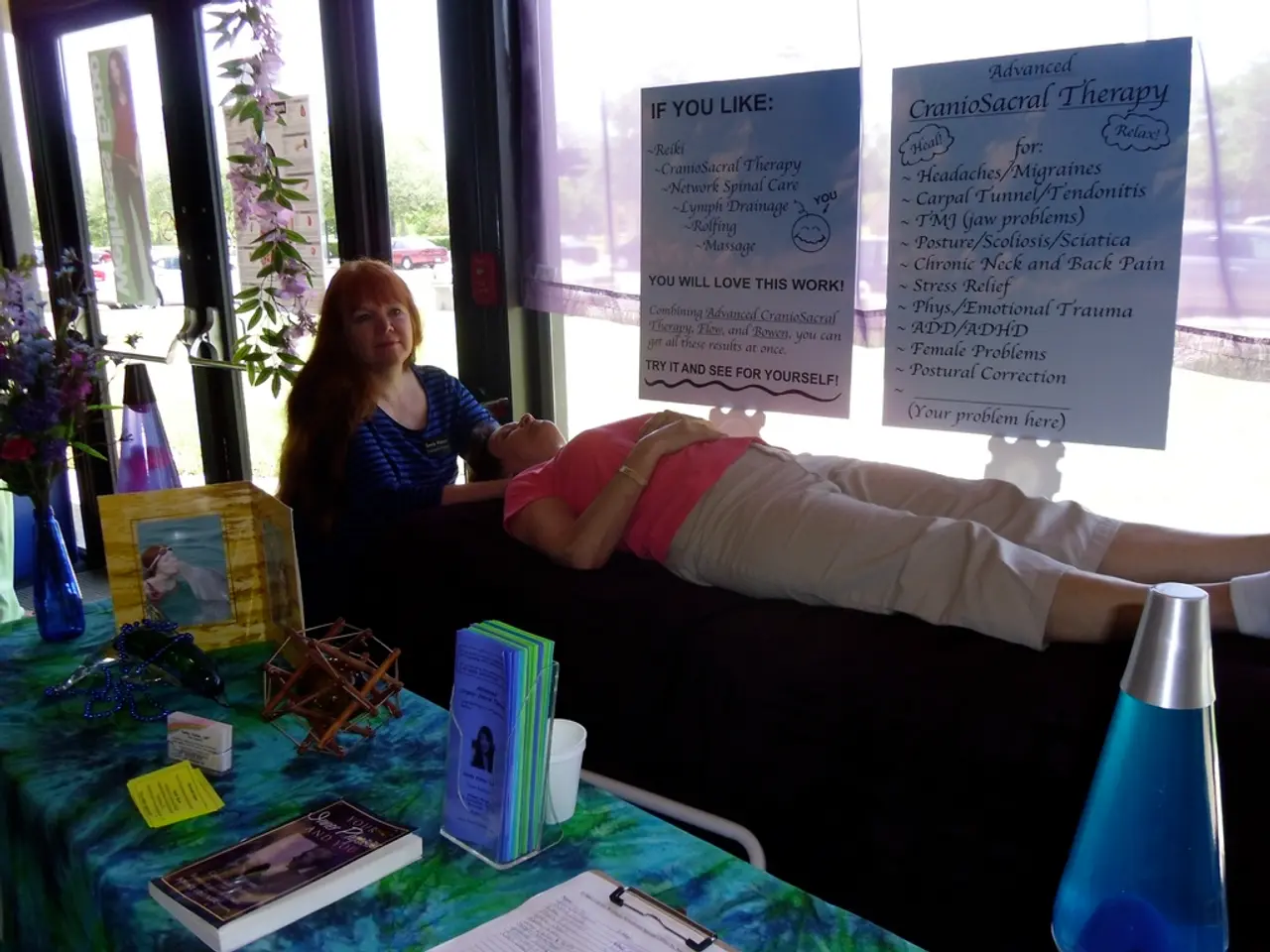Facial paralysis condition known as Bell's palsy, including potential causes, therapies, and indications.
Bell's palsy is a common condition that causes weakness or paralysis on one side of the face, often resulting from inflammation of the seventh cranial nerve, which controls facial muscles [1]. This idiopathic (unknown cause) condition, often thought to result from viral infection or an immune-mediated response, can lead to a range of complications that require early diagnosis and management.
Common symptoms of Bell's palsy include difficulty closing the eye, drooling, changes in saliva and tear production, changes in taste, sensitivity to sound, and facial pain [1]. Incomplete eyelid closure can cause dryness of the eye, irritation, and, if not managed properly, may lead to corneal ulceration and infection [1][2][5].
Treatment for Bell's palsy typically involves a combination of approaches. A 10-day course of oral steroids can reduce inflammation and improve the chances of a full facial recovery [6]. Over-the-counter pain relief medication can help reduce discomfort. Eye lubrication is important for people with Bell's palsy who may have difficulty blinking or closing their eye fully, as it can prevent dry eye and reduce the risk of eye damage or infection [7].
Physical therapists will recommend exercises suitable for each stage of recovery for people with Bell's palsy. These exercises help strengthen facial muscles and improve facial coordination [4]. Botulinum toxin type A (Botox) may also help restore facial symmetry, but it should be applied accurately to avoid reduced function or increased paralysis [2].
While the effectiveness of antiviral drugs in treating Bell's palsy is not clear, the National Institute of Neurological Disorders and Stroke recommends starting steroid treatment within a week of symptom onset [6]. Surgery may be necessary for people with Bell's palsy who do not see an improvement within a few weeks or months, and it can help prevent dry eyes, improve facial appearance, and reduce pressure on the nerve [8].
Risk factors for Bell's palsy include diabetes, high blood pressure, pregnancy, obesity, preeclampsia, and migraines [9]. The seventh cranial nerve can become inflamed due to various reasons, such as Lyme disease, Ramsay Hunt syndrome, trauma, tuberculosis, HIV, sarcoidosis, vasculitis, or a tumor [10].
Brushing and flossing teeth, attending regular dental checkups, and chewing food well are important for people with Bell's palsy to prevent problems in the mouth [3]. It's crucial to seek medical attention promptly to ensure proper management and improve the chances of a full recovery. Most people with Bell's palsy make a full recovery, but some complications are possible if damage to the facial nerve is severe [8].
References: [1] American Academy of Otolaryngology—Head and Neck Surgery. (2021). Bell's Palsy. Retrieved from https://www.enthealth.org/conditions/bells-palsy [2] Mayo Clinic. (2021). Bell's palsy. Retrieved from https://www.mayoclinic.org/diseases-conditions/bells-palsy/symptoms-causes/syc-20351871 [3] National Institute of Dental and Craniofacial Research. (2021). Dental Care for People with Bell's Palsy. Retrieved from https://www.nidcr.nih.gov/health-info/dental-care/people-special-needs/dental-care-bellspalsy [4] National Institute of Neurological Disorders and Stroke. (2021). Bell's Palsy Fact Sheet. Retrieved from https://www.ninds.nih.gov/Disorders/Patient-Caregiver-Education/Fact-Sheets/Bells-Palsy-Fact-Sheet [5] National Organization for Rare Disorders. (2021). Bell's Palsy. Retrieved from https://rarediseases.org/rare-diseases/bells-palsy/ [6] National Institute of Neurological Disorders and Stroke. (2021). Treatment for Bell's Palsy. Retrieved from https://www.ninds.nih.gov/Disorders/Patient-Caregiver-Education/Fact-Sheets/Bells-Palsy-Fact-Sheet#treatment [7] American Academy of Ophthalmology. (2021). Bell's Palsy. Retrieved from https://www.aao.org/eye-health/diseases/bells-palsy-fact-sheet [8] American Academy of Facial and Reconstructive Plastic Surgery. (2021). Bell's Palsy. Retrieved from https://www.aafprs.org/patient-resources/conditions-procedures/bellspalsy [9] National Institute of Neurological Disorders and Stroke. (2021). Risk Factors for Bell's Palsy. Retrieved from https://www.ninds.nih.gov/Disorders/Patient-Caregiver-Education/Fact-Sheets/Bells-Palsy-Fact-Sheet#risk-factors [10] American Academy of Otolaryngology—Head and Neck Surgery. (2021). Bell's Palsy. Retrieved from https://www.enthealth.org/conditions/bells-palsy/causes
- Bell's palsy is associated with various risk factors, such as diabetes, high blood pressure, and migraines, indicating a close link between health-and-wellness and chronic-diseases.
- The scientific community continues to explore predictive factors for Bell's palsy, including cerebral palsy, asthma, and mental-health conditions, to better understand the underlying mechanisms and potential preventive measures.
- In addition to managing Bell's palsy, maintaining fitness-and-exercise, skin-care, and proper nutrition become crucial components of overall health and wellness.
- Antiviral drugs may not be effective in treating Bell's palsy, but early diagnosis and management remain key to improving the chances of a full recovery, demonstrating the importance of science in medical-conditions management.
- Physical therapists play a vital role in facilitating recovery for people with Bell's palsy, guiding them through exercises targeting facial muscles and coordination, thus combining the art and science of healing.
- Cancer and other serious chronic diseases can sometimes lead to complications similar to Bell's palsy, highlighting the interconnectivity of various health issues and the need for comprehensive and coordinated care.
- Preventing problems in the mouth, such as tooth decay and infection, is essential for people with Bell's palsy, emphasizing the importance of dental care in overall health and wellness.




